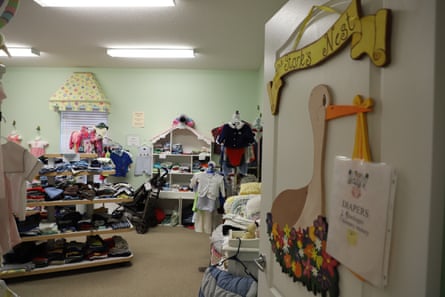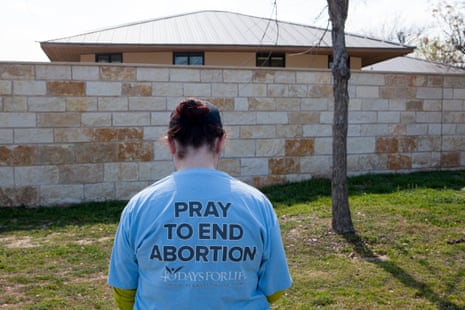At least 10 US states have siphoned millions of dollars from federal block grants, meant to provide aid to their neediest families, to pay for the operations of ideological anti-abortion clinics.
These overwhelmingly Republican-led states used money from the federal Temporary Assistance for Needy Families program (Tanf), better known as welfare or direct cash aid, to fund the activities of anti-abortion clinics associated with the evangelical right. The clinics work to dissuade women from obtaining abortions.
In all cases, the states used these funds even as Covid-19 caused the worst economic upheaval in nearly a century, left one in four families without enough to eat, and resulted in mass layoffs that had a disproportionate effect on low-income and racial minority Americans.
“They’re not a replacement for Tanf, by any stretch of the imagination,” said Andrea Swartzendruber, an associate professor of epidemiology and biostatistics at the University of Georgia College of Public Health, whose research has focused on how crisis pregnancy centers operate.
Indiana, Louisiana, Michigan, Missouri, North Carolina, North Dakota, Ohio, Oklahoma, Pennsylvania and Texas have used federal Tanf funds to support anti-abortion clinics.
The revelation is to be published in a report by the accountability group Equity Forward, which was provided exclusively to the Guardian. Equity Forward produces investigative research on human rights, gender equity and sexual and reproductive health and justice.
These 10 states funneled the money through “Alternatives to Abortion” programs, part of state budgets established by conservative legislatures and often run through state health departments. They not only send millions in federal welfare funds, but also state taxpayer dollars to such centers.
Clinton-era welfare reforms caused, “a fundamental shift in how cash assistance to families with children with little or no income was funded”, said Ife Floyd, a senior policy analyst at the Center on Budget and Policy Priorities.
“States have control over those dollars in a way they didn’t necessarily have before,” Floyd added.

The result has been increasingly dramatic variation in how states spent the federal dollars. States, especially in the south, have imposed harsh eligibility requirements in debates marred by racism, and pushed people off benefits even in times of economic turmoil, such as the Great Recession and the Covid-19 pandemic.
As the 2001 book Welfare Racism described it, legislators developed a “preoccupation with controlling the alleged sexual immorality and supposed preference of welfare over work of one group: African-American females”.
Missouri is one such example of how welfare has withered. In 2015, the state passed draconian welfare reforms that imposed a 45-month lifetime limit for cash assistance, work requirements and sanctions for people who did not comply.
“We’ve created a new class of Missourians,” Glenn Koenen, a hunger adviser with the left-leaning group Empower Missouri, said at the time the reforms were passed. “We now have legislated that some of our neighbors are too poor to get help from anti-poverty programs.”
Between 1 January 2016, when the reform went into effect, and April 2021, more than 71% of beneficiaries dropped off Missouri’s program. That included 28,643 children and 16,942 families.
Missouri then spent funds not paid to families on other programs, among them the Alternatives to Abortion program. Since 2017, it has sent $26m to anti-abortion clinics, according to state budgets. The average monthly benefit for a Missouri family is $256.
The program gained traction after it was pioneered in 2001 by the former Pennsylvania senator Rick Santorum, who also helped craft the 1990s welfare reforms that made such state spending possible. That year, Pennsylvania became the first state to divert Tanf funds to anti-abortion clinics, and sent $1m to its Alternatives to Abortion program.
The program was then popularized with help from the Pennsylvania-based anti-abortion clinic Real Alternatives, whose representatives went on to “educate” other anti-abortion organizations about how to obtain state funding.
Conservative states then replicated the program as welfare reform passed out of the public spotlight, abortion restrictions proved a winning strategy for Republicans, and anti-abortion clinics lobbied for more funds. Ohio Right to Life, for example, said it “pursued” federal welfare funds for three years in a row.
While there is no public accounting of all the federal funds anti-abortion clinics have received in the last two decades, Texas’s large program sheds light on the sheer volume of cash.
Since 2006, Texas has sent $45m in federal welfare funds to crisis pregnancy centers. Texas has extraordinarily strict income limits for its welfare program – a family of four can earn no more than $231 per month to be eligible.
Conservative lawmakers have argued anti-abortion clinics provide assistance to the needy by helping women who unexpectedly find themselves pregnant or in “crisis”. They are targeted to the young, low-income and people of color. Driven by an ideological agenda, they universally oppose abortion, and are often affiliated with large evangelical or Catholic networks.
However, many experts have described crisis pregnancy centers as “unethical” and deceptive, because they pose as medical facilities and offer “medically unnecessary” ultrasounds. Most often, medical services do not go beyond tests for sexually transmitted infections.
“I don’t think the concern is clinics that offer alternatives to abortion,” said the former Missouri representative Deb Lavender, who in 2017 introduced a bill to stop Missouri from giving welfare funds directly to crisis pregnancy centers. “The concern is that they lie to women and they trap women” through omission or misinformation, she said.
Others may encourage women to wait to have an abortion, exaggerate the risk of miscarriage, or draw spurious links between abortion and breast cancer, depression and future infertility.
Outside of STI tests, what crisis pregnancy centers provide most often are diapers, wipes, clothes and perhaps car seats, said Swartzendruber. But those items come with a cost.
“People, in order to get those goods and materials, have to basically earn them with their time and effort – whether it’s watching videos [or] going to Bible studies,” Swartzendruber said. “Someone in need could not expect to show up to a crisis pregnancy center and just get diapers. They have to be earned over time.”
State funding streams have also resulted in a dramatic imbalance in the number of anti-abortion clinics versus full-service reproductive health providers, who are under near-constant attack.
Today, there are more than 2,500 ideologically focused, anti-abortion clinics, compared with just 800 abortion providers. But those figures don’t tell the whole story, as they are dramatically skewed in states hostile to abortion rights.
In some states, the balance is one abortion provider to 15 anti-abortion clinics. In Missouri, that balance is one to 74, as the state has worked aggressively to shut down its only remaining abortion clinic, a Planned Parenthood in St Louis.
Many states have chosen to divert these funds amid chronic budget shortfalls, shield centers from public scrutiny and allow contractors to conduct their own oversight.
In 2017, Oklahoma ranked number one in cuts to education and female incarceration. Nevertheless, the state chose to continue to divert Tanf funds to crisis pregnancy centers even amid chronic budget deficits.
Advocates have also been blocked in their attempts to understand how crisis pregnancy centers work with state agencies. Missouri has attempted to charge Equity Forward $26,219 for an open records request for emails.
Often, crisis pregnancy centers used federal welfare funds and state taxpayer dollars with little oversight. In North Dakota and Oklahoma, the only oversight provision in contracts states crisis pregnancy centers must be “outcome-driven with positive results”.
Pennsylvania’s Alternatives to Abortion program gave $30m to Real Alternatives alone from state and federal funds from 2012 to 2017. Real Alternatives then used that money to set up pregnancy centers in Michigan, using “hundreds of thousands of Pennsylvania taxpayer dollars to fund its activities in other states”, Pennsylvania’s auditor general, Eugene DePasquale, said in 2017.
“It is just as outrageous that the state grant agreement was so weak that it allowed this practice to go on for decades siphoning funds intended to benefit Pennsylvania women experiencing crisis pregnancies,” the auditor general said.
Despite the problems these programs have encountered, their popularity continues to grow among conservative legislators. Arkansas, Arizona and Iowa all sought to establish Alternatives to Abortion programs in 2021, even amid the pandemic-devastated economy.
